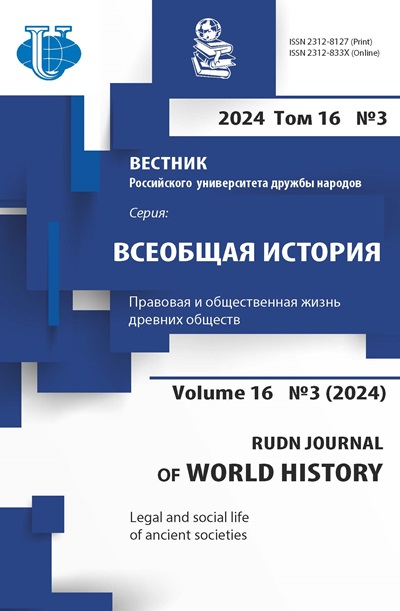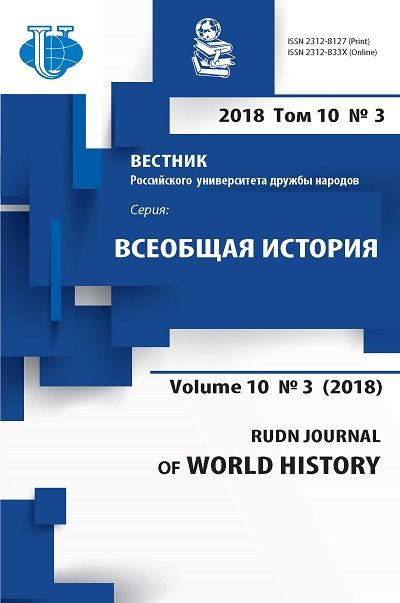Kalmak and oirats: toponym in the religious history of the peoples of Central Asia
- Authors: Kitinov B.U.1
-
Affiliations:
- Peoples’ Friendship University of Russia (RUDN University)
- Issue: Vol 10, No 3 (2018)
- Pages: 270-281
- Section: Oriental Studies
- URL: https://journals.rudn.ru/world-history/article/view/20676
- DOI: https://doi.org/10.22363/2312-8127-2018-10-3-270-281
Cite item
Full Text
Abstract
The word Kalmak is spread in a number of medieval Muslim sources. In research of the scholars this word is understood as an indicator of development or separatism (“piece”, “backward”), or religious orientation (not Muslims) for Oirats or some kind of nomadic people. To define the origin and development of its meaning, it is important to draw data from a number of important sources; for example, according to “Tarikh-i Rashidi”, Kalmak means the territory of Western and South-Western Mongolia, whose inhabitants were called, respectively, as Kalmaks, and mainly were not Muslims. In the context of the struggle of different Islam traditions during the process of Islamization of the uluses of Juchi and Chaghatay, this word began to denote all those who remained pagan or Buddhist, and since such “refuseniks” had been found in all the Genghisid uluses, the sources recorded the presence of Kalmaks almost everywhere. Besides, the historical tradition relates the Buddhist Oirats to Kalmaks, but initially Oirats had nothing common with that nation, and only with Oirats’ movement in Genghis Khan’s times to the named territories (Kalmak), this word was transferred to them, already, as an ethnonym. Oirats became Buddhists at the end of the fourteenth - beginning of the fifteenth centuries, facilitated by political, economic, ideological and other reasons. A study of the sources leads to conclusion, that the Kalmak’s first meaning was the region’s name, where peoples were known as not Muslims, and therefore this word acquired a religious context and for this reason was finally entrenched to the Oirats.
Keywords
About the authors
Baatr Uchaevich Kitinov
Peoples’ Friendship University of Russia (RUDN University)
Author for correspondence.
Email: kitinov@mail.ru
PhD in History, Associate Professor of the Department of World History, Faculty of Humanities and Social Sciences
10-2 Miklukho-Maklaya St., Moscow, 117198, RussiaReferences
- Alekseev A.K. Political history of the Tukay-Timurids: Based on the materials of Bahr al-asrar, the Persian historical work. SPb.: St. Petersburg University, 2006. 228 p. (In Russian)
- Bakunin V.M. Description of the Kalmyk peoples, and especially of them Torgaut, and the deeds of their khans and owners. Writing of 1761. Elista: The Kalmyk Publishing House, 1995. 153 p. (In Russian)
- Barthold V.V. Works on the history and philology of the Turkic and Mongolian peoples // Collected Works. Moscow: Nauka, 1968. 759 p. (In Russian)
- Damdinsuren C. Historical roots of the Geseriada. M.: Russian Academy of Sciences, 1957. 240 p. (In Russian)
- Dryemov I.I. Kalmaks of Desht-i-Kypchak (to the problem of Turkization and Islamization of the Mongols in the Golden Horde) // Proceedings of the Saratov University. Issue: History. International relations. Vol. 14. No. 4. 2014. Pp. 96–101. (In Russian)
- Dryemov I.I. Kalmaks of Middle Asia of XIV–XVI centuries // Herald of the Caspian region: archeology, history, ethnology. No. 3. 2012. P. 104–117. (In Russian)
- History of Kalmykia from Ancient Times to Our Days. Elista, 2009. Vol. 1. 848 p. (In Russian)
- Karma Trinley. History of the Karmaps of Tibet. M.: Diamond Way, 2010. 221 р. (In Russian)
- Kitinov B.U. Emir Nouruz and the spread of Islam among the Oirats in Persia // LOCUS: people, society, cultures, meanings. No. 3. 2017a. Pp. 41–52. (In Russian)
- Kitinov B.U. “Oirat-Ogelds.. have crossed the Mankan River”: the ethno-religious situation in the Oirats in the middle of the XV – beginning of the XVI centuries // Bulletin of the Peoples’ Friendship University of Russia. Series: The world history. Vol. 9. No. 4. 2017b. Pp. 370–382. (In Russian)
- Kitinov B.U. The Sacred Tibet and the Warlike Steppe: Buddhism in Oirats (XIII–XVII centuries). M.: KMK Scientific Publications Group, 2004. 190 p. (In Russian)
- Kotvich V.L. The Russian archival documents on relations with Oirats in the XVII– XVIII centuries. The News of the Russian Academy of Sciences. No. 12–15. Pg., 1919. (In Russian)
- Moiseyev V.A. Dzungarian Khanate and Kazakhs (XVII–XVIII centuries.). Alma-Ata: Gylym, 1991. 238 p. (In Russian)
- Nominkhanov Ts.D. The Origin of the Ethnonym ‘Kalmyk’ // Bulletin of the Academy of Science of the Kazakh SSR. No.11. 1958. Pр. 99–103. (In Russian)
- Sanchirov V.P. “Kalmaks” in the “History” of the Turkish author of the 16th century Seifi Chelebi // Little researched sources on the history of pre-revolutionary Kalmykia and the tasks of their study at the present stage. Elista, 1987. Pр. 6–27. (In Russian)
- Tizengauzen V.G. Collection of Materials Relating to the History of the Golden Horde. Extracts from Persian works, processed by A.A. Romaskevich and S.L. Volyn. Moscow– Leningrad, Publishing house of the Academy of Sciences of the USSR, 1941. 308 p. (In Russian)
- Tizengauzen V.G. Collection of Materials Relating to the History of the Golden Horde. Extracts from Arabic works. St. Petersburg: Printing house of the Imperial Academy of Sciences, 1884. XVI, 564 p. (In Russian)
- Haidar Mirza Muhammad. Tarih-i Rashidi. Tashkent: Fan, 1996. 727 p. (In Russian)
- Reader on the history of China in the Middle Ages (XV–XVII centuries.). M.: Publishing house of Moscow State University, 1960. Pp. 86–87. (In Russian) URL: http://www. vostlit.info/Texts/Dokumenty/China/XV/Chrestomat/text3.htm (accessed 7.06.2018)
- Sharaf ad-Din Yazdi. Zafar-Nama / transl. from the Persian by A. Akhmedov. Tashkent: SANAT, 2008. 484 p. (In Russian)
- Erdniev U.E. Kalmyks. Elista: Kalmyk book publishing house, 1980. 282 p. (In Russian)
- Elverskog J. Buddhism and Islam on the Silk Road. University of Pennsylvania press, 2010. 340 p.
- Islam and Tibet: Interactions Along the Musk Routes, ed. Anna Akasoy et. al. Ashgate, 2010. 391 р.
- Karmay H. Early Sino-Tibetan Art. Aria & Phillips ltd., 1975. 128 р.
- Richardson H.E. The Karma-Pa Sect. A Historical Note // Journal of the Royal Asiatic Society. October, 1958. Pp. 139–164.
- Roerich G. The Blue Annals. Vol. 1. Delhi, 1976.
- Ron Sela. Central Asian Muslims on Tibetan Buddhism, 16th–18th Centuries // Trails of the Tibetan Tradition. Papers for Elliot Sperling. Ed. by Roberto Vitali with assistance from Gedun Rabsal and Nicole Willock. Dharamshala (H.P.), India 2014. Рр. 345–359.













